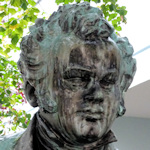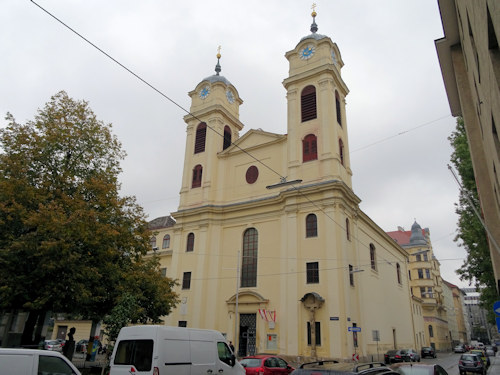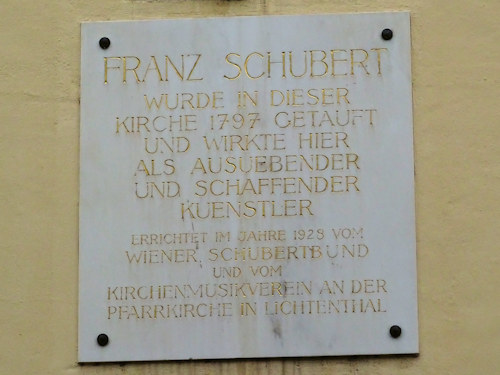
The 18th-century Lichtentaler church now carries the common name Schubertkirche and for good reason: Franz Schubert’s early years were intimately tied up with both the church and the surrounding parish.
- Beautiful working Baroque church
- Many connections to Schubert’s life and music
- Book a concert experience* for Vienna
- See also:
The church & Schubert

(The Lichtental parish church)
Emperor Charles VI laid the foundation stone for the Schubertkirche in 1712, though nobody at that ceremony probably imagined quite what that building would eventually go through.
A reconstruction and expansion project a few decades after construction is par for the course for old churches.
However, an explosion at a nearby gunpowder facility, floods, the Napoleonic occupation of Vienna, and WWII bombing raids don’t normally trouble most places of worship. The Schubertkirche survived all of these, though.
The connection to Schubert began with his father, who married here in 1785 and ran the parish school. Schubert himself was born three streets away and christened in the church in February 1797.
The famous composer subsequently sang in the choir, played the organ and other instruments during recitals and, eventually, composed and conducted music for the church itself.

(A plaque highlights the Schubert association)
Various religious pieces from the hand of Schubert premiered here, including his early Mass compositions. Public concerts in the church still perform his works.
Outside the Schubertkirche, a plaque commemorates the connection, as does a 20th century bust by the famous Austrian sculptor, Gustinus Ambrosi (who also designed the gravestone of Ludwig Boltzmann).
The plaque says (my loose translation of the German):
Franz Schubert was baptised in this church in 1797 and appeared here as both a performer and creator of works. Erected in the year 1928 by the Wiener Schubertbund* and the Church Music Association of the Lichtenthal Parish Church
*The Vienna Schubert choir still going strong today
And inside?
The first thing you encounter inside the church is a non-descript wall of glass that feels like a disappointment…until you go through its doors and are transported into 18th-century Vienna.
Giant stone arches with illusionist paintings create the impression of detail and grandeur.
Roof frescoes illustrate biblical scenes and themes, while the walls feature a series of paintings depicting fourteen stations of the cross.
And old wooden pews lead down to the altar and the huge painting of the fourteen holy helpers.
A look back down the church from that altar reveals, of course, the magnificent organ.

(Drawing of the church by Salomon Kleiner, engraved by Johann August Corvinus and published by Johann Andreas d. Ä. Pfeffel in 1733; Wien Museum Inv.-Nr. 105765/81; excerpt reproduced with permission under the terms of the CC0 licence)
Although it has been refurbished and rebuilt, the organ still retains some original parts from Schubert’s days.
You can easily imagine a bespectacled young lad in this beautiful setting, reveling in a new composition or merrily directing singers and musicians .
I was particularly impressed by the richly-decorated raised pulpit that protrudes from one wall. Garlands of sculpted golden flowers and leaves hang from its base, and this theme pervades the whole church.
And after?
If you’re looking for more Schubert-related locations in Vienna, then I have a list here that covers his life, music and memorials.
And, unsurprisingly, the city also has a large number of other historical churches: from the giant Stephansdom cathedral to Baroque beauties like the Peterskirche. Many have a connection to one of Vienna’s composers and many still host classical concerts today.
How to get to the Schubertkirche
The building is a short walk from various public transport routes. For example:
- Franz Josefs Bahnhof (railway station), which is served by trams 1, D, 5 and 33, as well as the S40 city train
- Canisiusgasse, on the 37 and 38 tram lines
- Althanstraße, on the 1, 33 and D tram lines
Address: Marktgasse 40, 1090 Vienna | Website